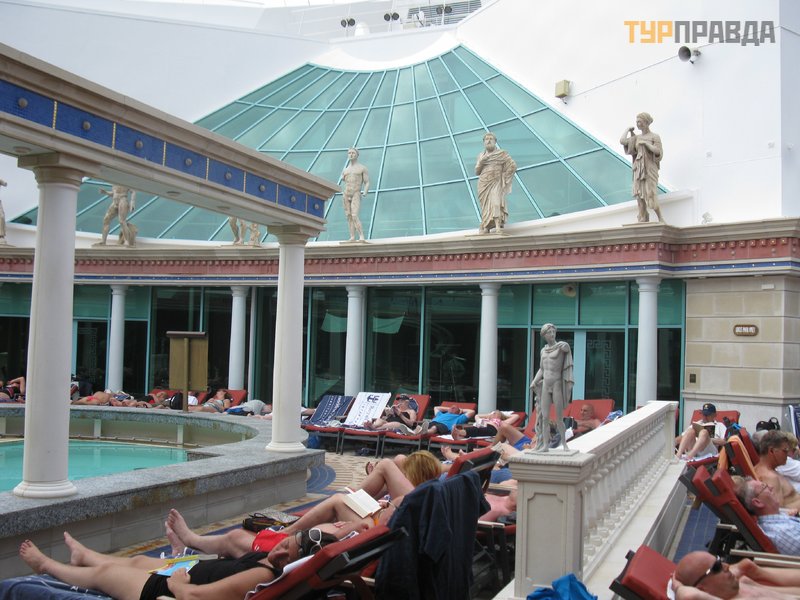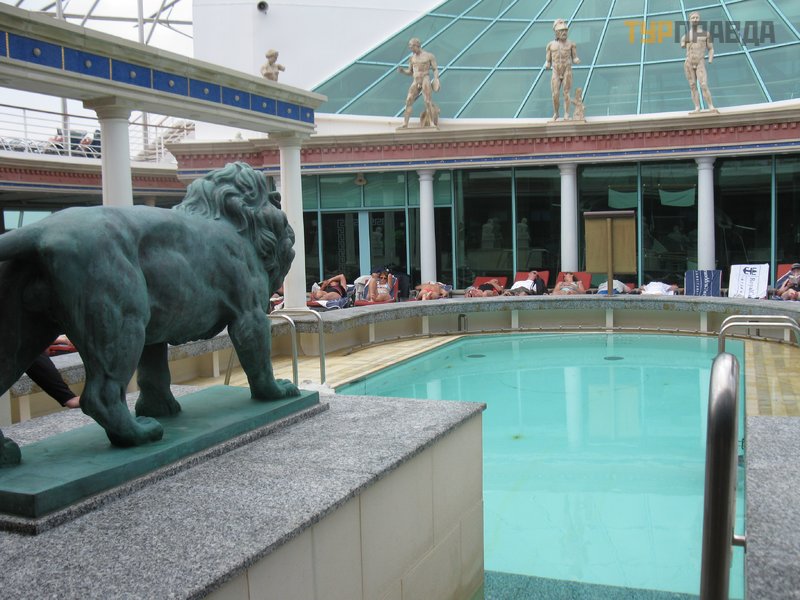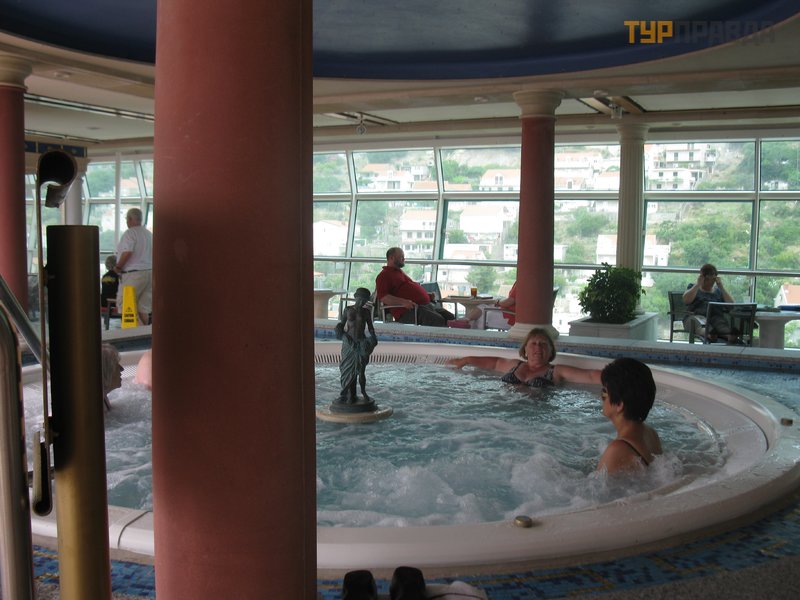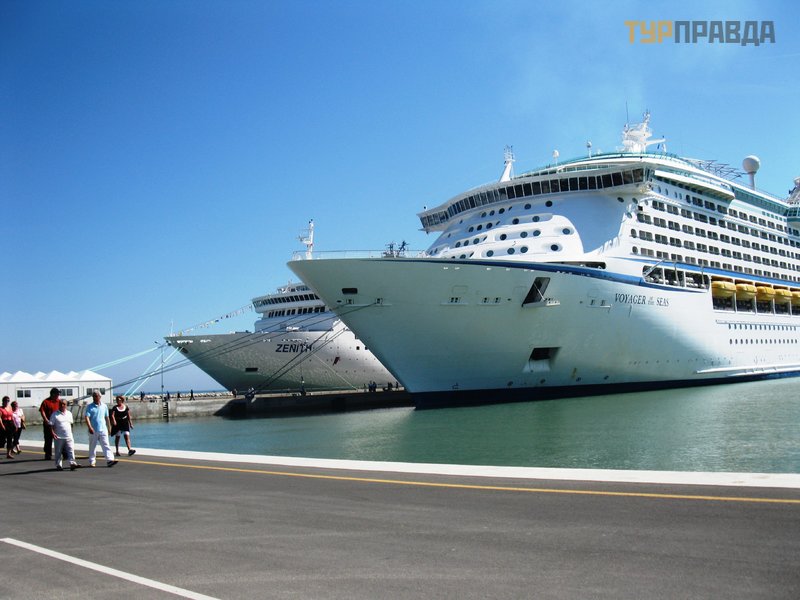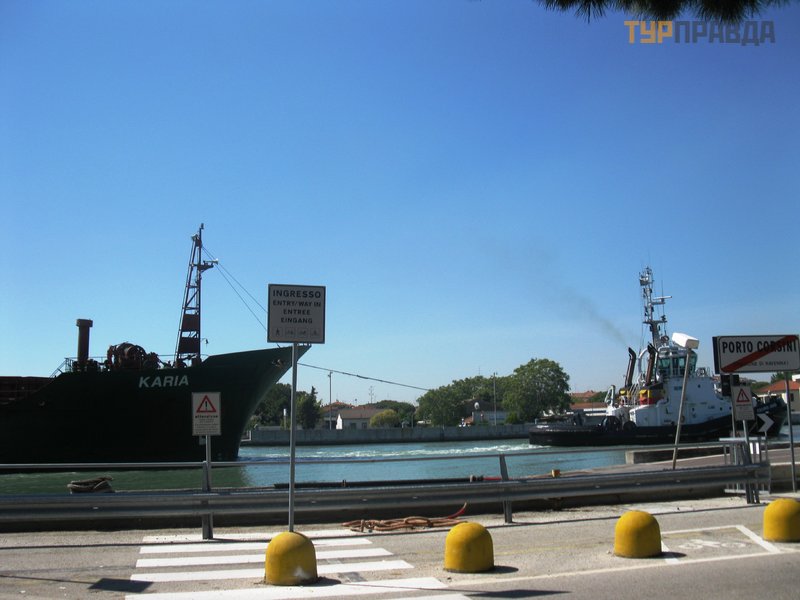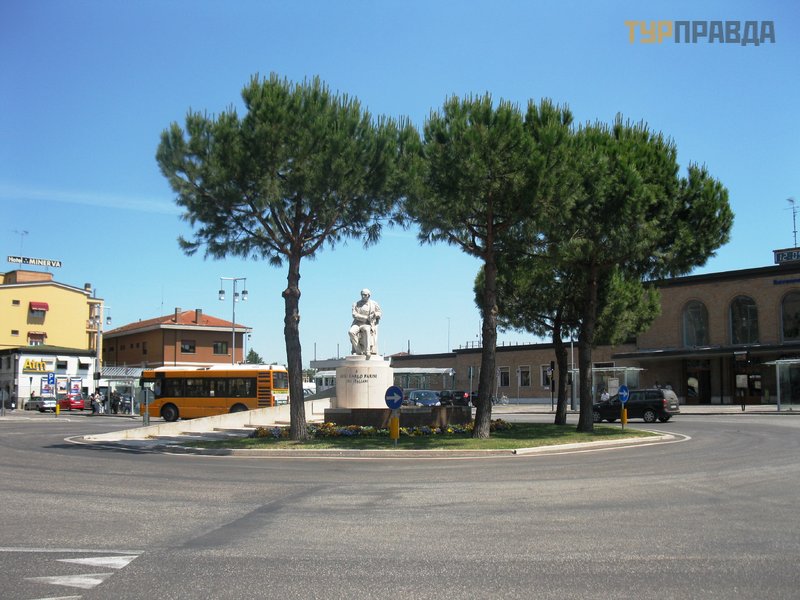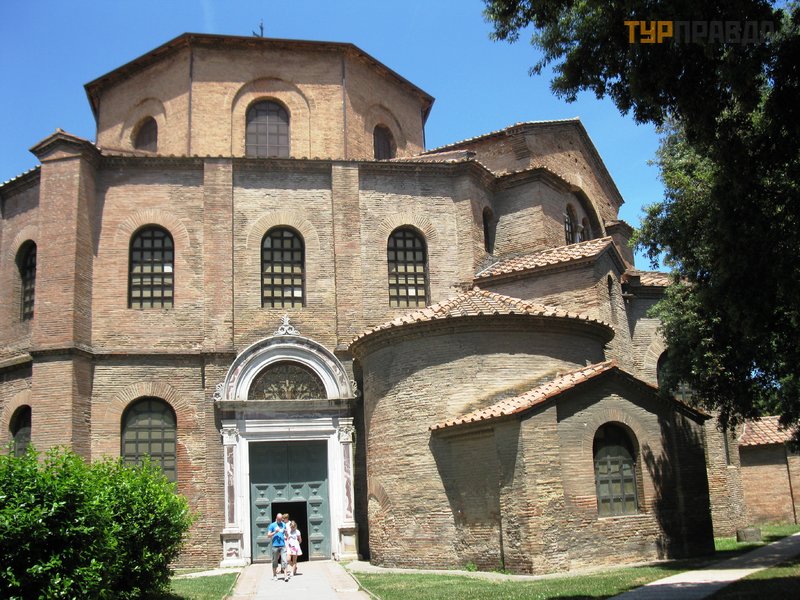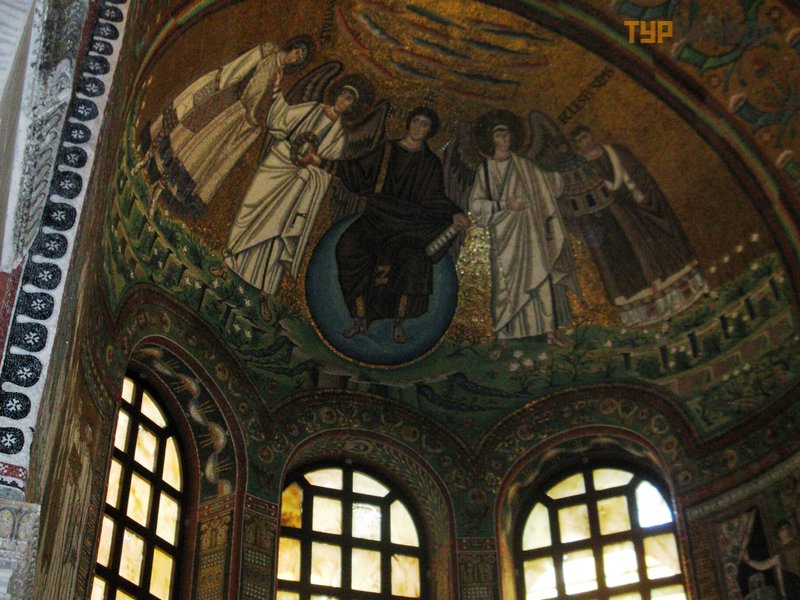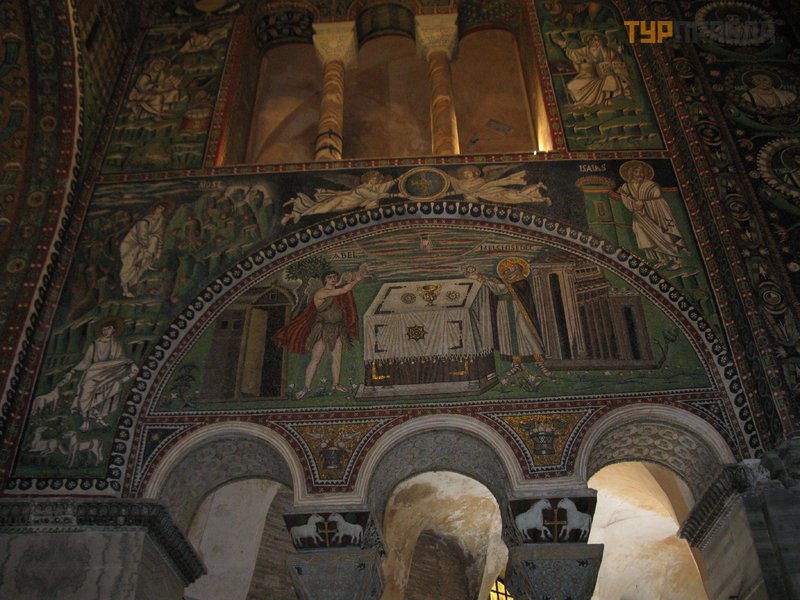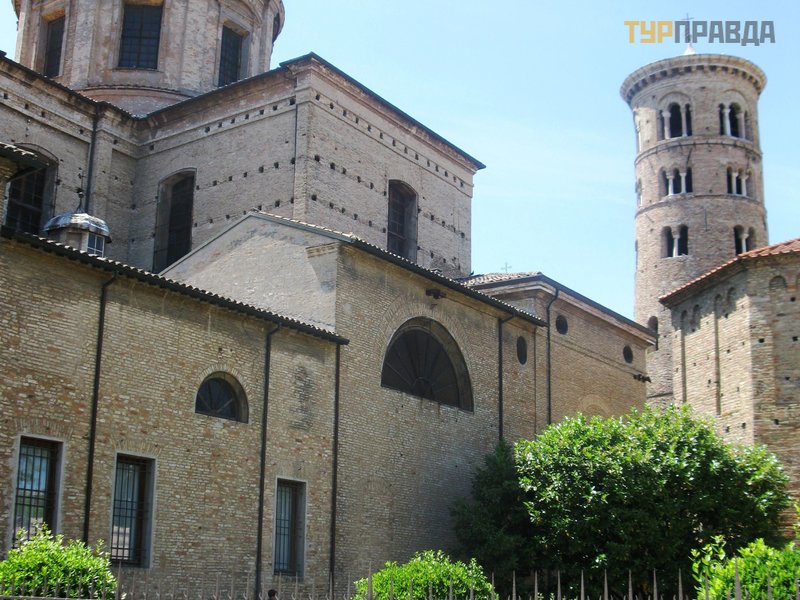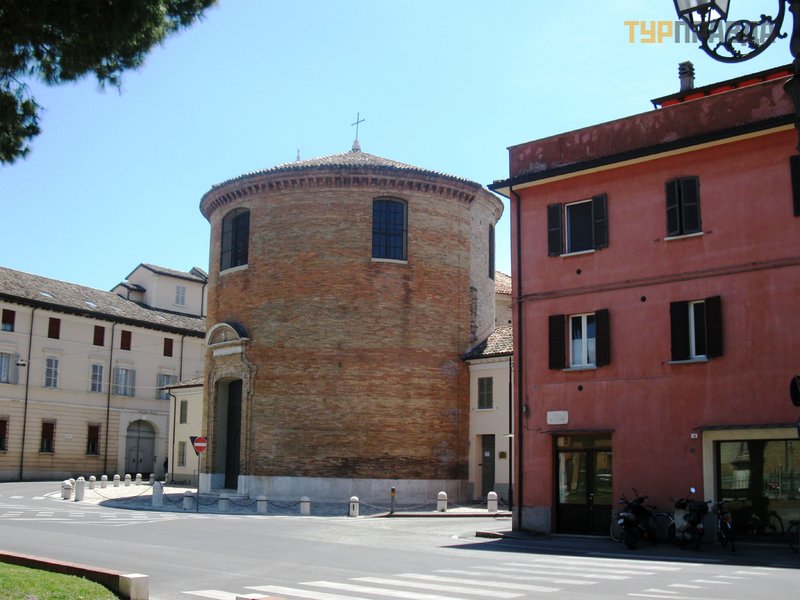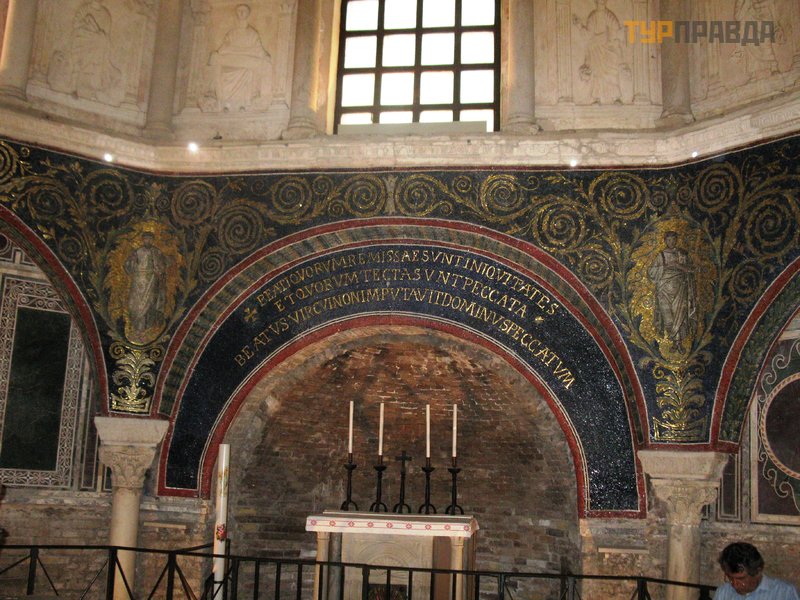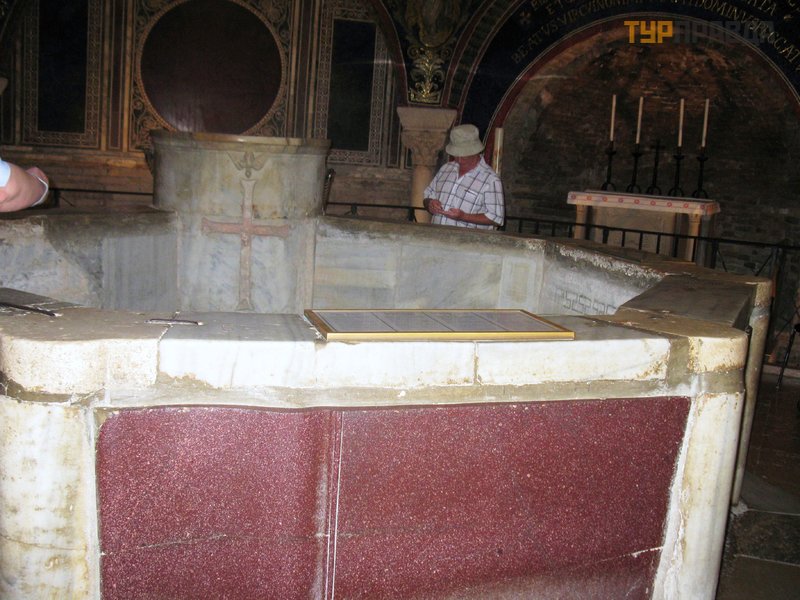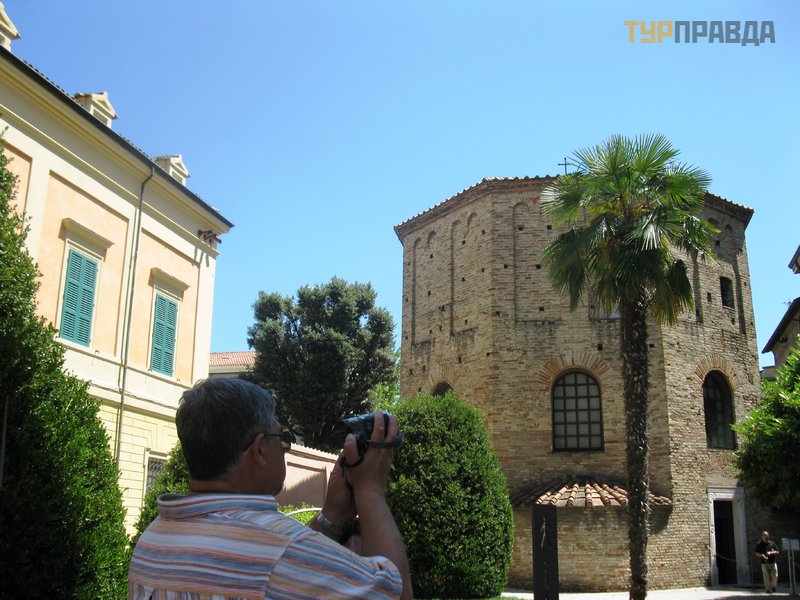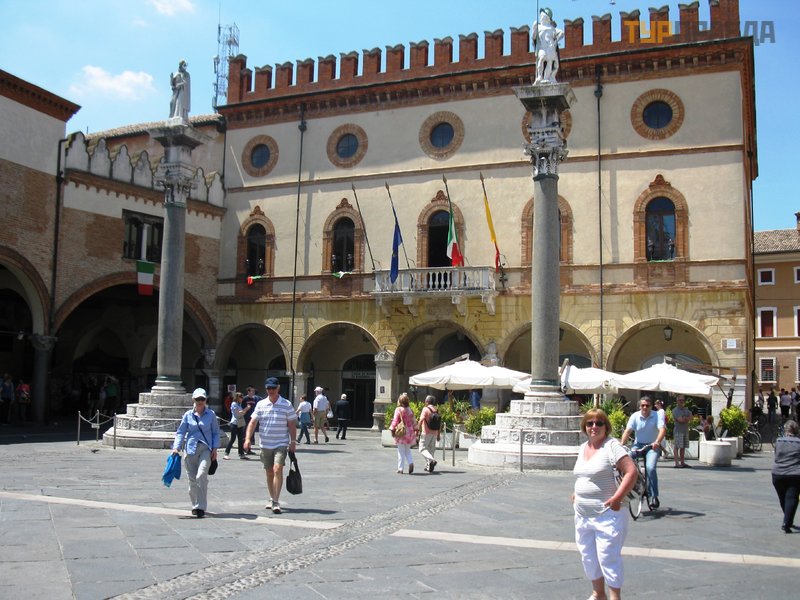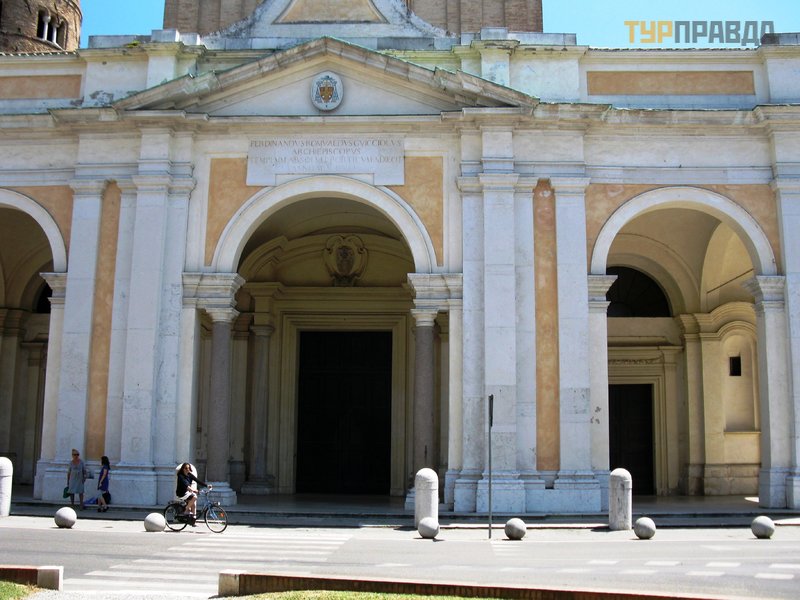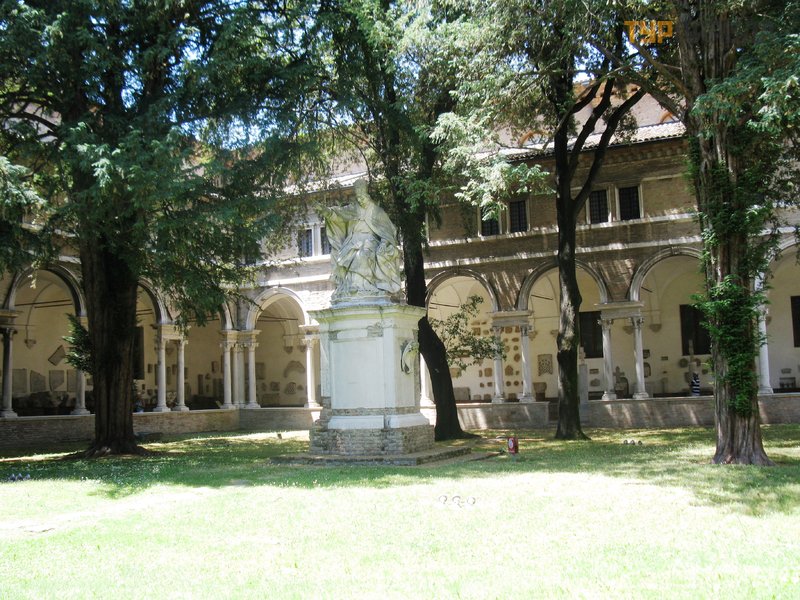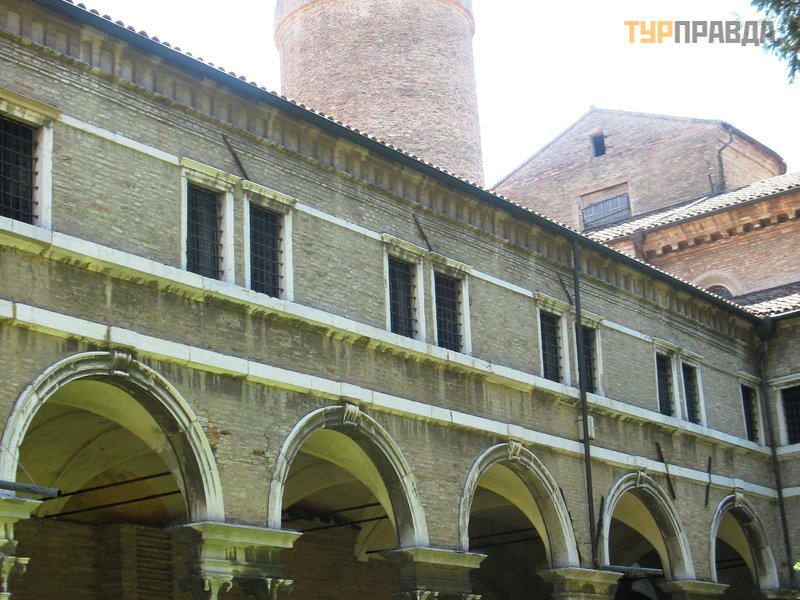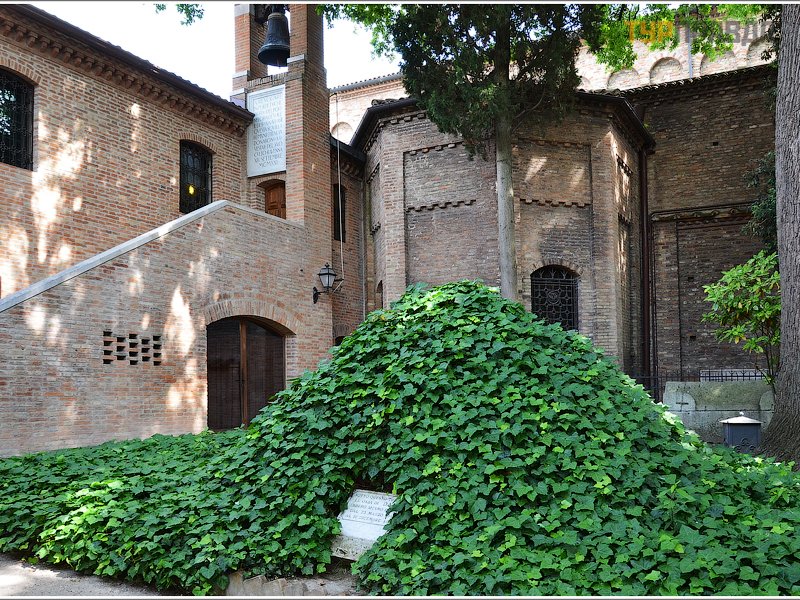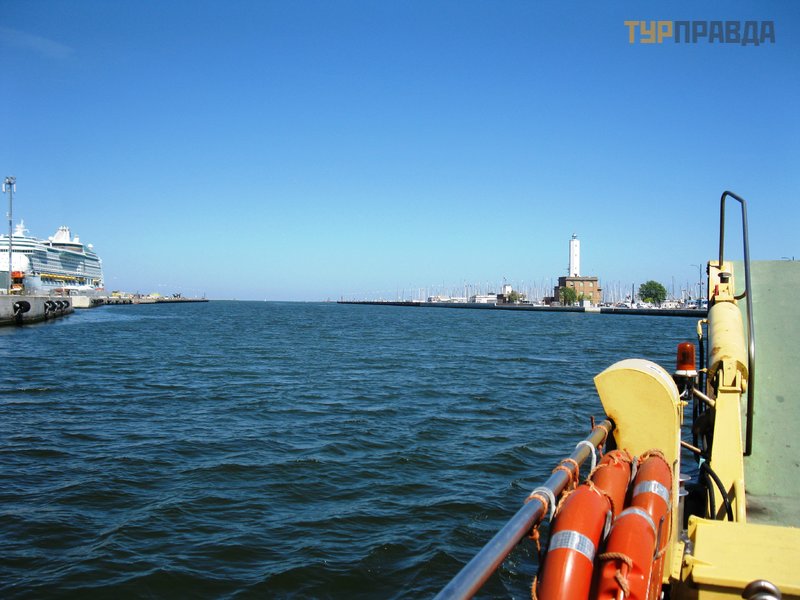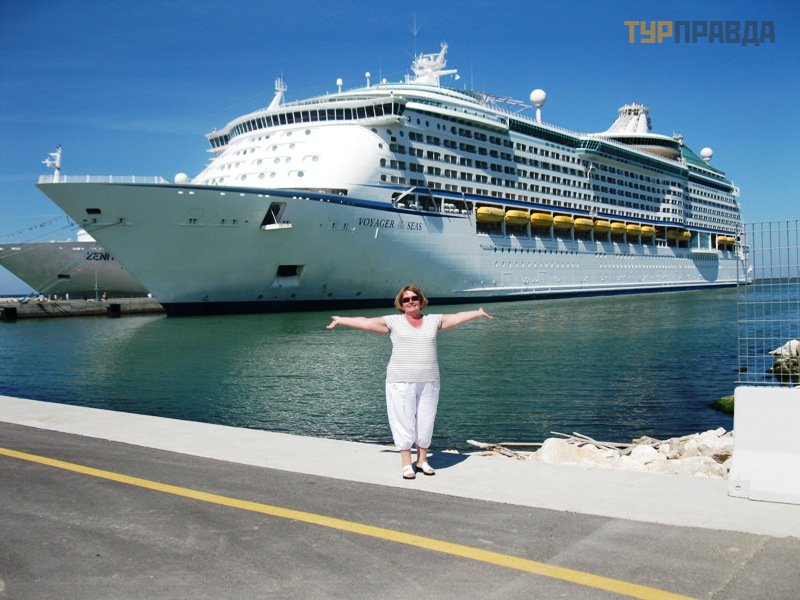Adriatic Cruise from Venice Part 4
To be continued - start here
The route is designed so that in the morning we are sure to be in the port - Koper, Ravenna, Bari, Dubrovnik, only once a day crossing the Adriatic Sea, but there was such a program of entertainment on board that no one was overlooked. Near the pool - a concert of musicians from Puerto Rico, competitions, tables with meals, fruits, soft drinks and sweets were also organized there. This is in addition to the usual drinks - coffee, teas, ice cream (which are always until late in the evening). There are two pools with sea water on the ship, there are also four jacuzzis,
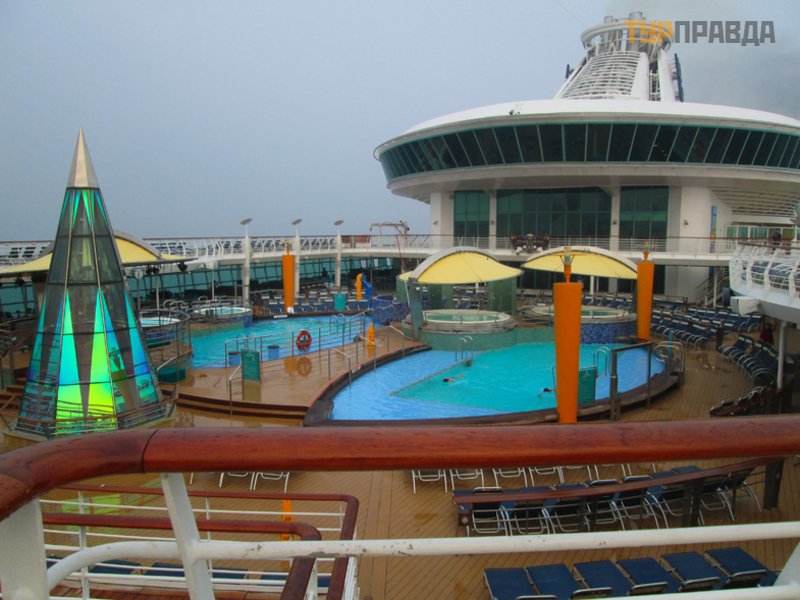 Pools and jacuzzis on the upper deck
Pools and jacuzzis on the upper deck
but more I liked to be in the part of the ship, finished in Roman baths.
A marble pool with sculptures, well, on sun loungers, so to speak, "Roman patricians". It was practically impossible to see everything on the ship, it was necessary to increase the day to 48 hours, entertainment was for every taste.
All cities are different, each city met us with its own peculiarities. In Koper we were greeted with a whole fair dedicated to our cruise, because the liner entered this port for the first time. Tastings of local wines and dishes, national costumes and music, brass bands - everything was for us. Bari treated those who came ashore with cherries, all the women with roses, they danced the tarantella. In each city, the meeting of the ship had its own twist.
In the morning, the cruise ship “Voyager of the Seas” arrived in Ravenna.
The offer to go to Ravenna by bus, paying $ 30 for two, did not suit us, we decided to conduct a tour of Ravenna on our own.
So a group of independent tourists got off the ship and went to look for a transfer to Ravenna, because it is about 20 km away. Someone grabbed a taxi for $ 20, we got to the ferry, which was ferried across the canal,
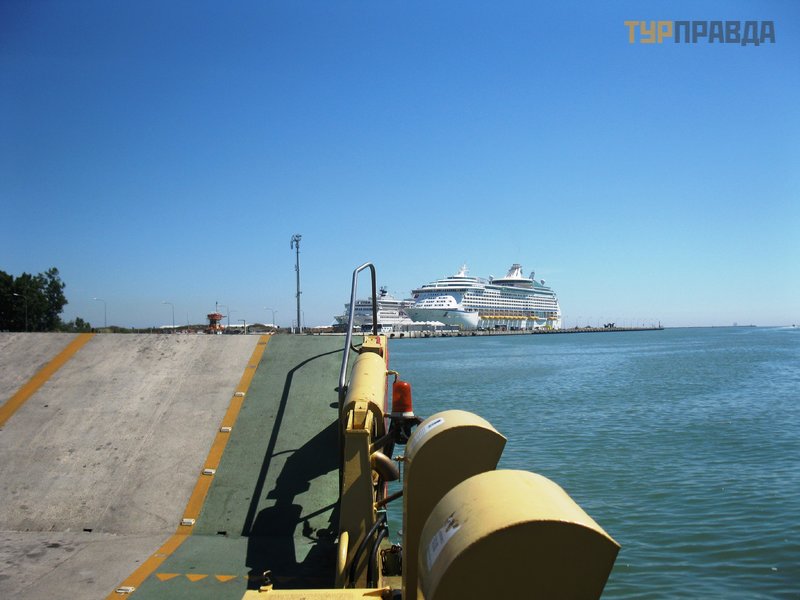 Leaving the cruise port by ferry
Leaving the cruise port by ferry
and there is a bus to Ravenna. The ferry is about 300 m, the crossing for two is 1 euro, the bus to Ravenna to the railway station paid 4 euros. The whole journey is within 40 minutes. The bus runs every 20 minutes.
As you understand, the cruise port in Ravenna is not in the city, so you need to choose either a transfer from the ship, or this route, like ours. The road to Ravenna passes by the beaches, so you can decide either historical sites or beaches. The end of the bus is the railway station, we also returned back on this bus. At the bus stop - the schedule, take a picture of it, it will come in handy
In Ravenna you will touch eternity. It is best to start with the Church of St. Vitaly - perhaps the most interesting building in the city, founded in the 6th century.
This brick octagon looks maybe a little unwieldy. However, it is worth going inside - and you definitely have never seen anything like this in your life! The dome is supported by eight internal columns, around which there is a two-story bypass. On the vault there is a unique mosaic on biblical motifs. Between the pillars there are two-storey arcades curved towards the walls of the structure. This technique dramatically increases the interior space. It becomes completely incomprehensible to the human eye how so many interior details could fit in not the largest room.
Here, nearby, is the National Museum, which contains an extensive collection of coins from the Roman period, unique examples of ivory carvings and ancient weapons.
Across the road you can see a real monument of the 5th century - the mausoleum of Galla Placidia, a Roman princess. And although most historians are sure that the ashes of Galla are not here, this makes the appearance of the structure no less impressive. A single ticket to the Basilica of San Vitale, the mausoleum of Galla Placidia, the Baptistery of the Orthodox, the museum in the Archbishop's Palace and the Basilica of Sant'Apollinare Nuovo costs 10.50 euros.
....
The historic center of Ravenna is literally saturated with the spirit of the early Middle Ages - squat, powerful buildings stand out against the backdrop of small residential houses painted in soft colors, shops and cafes. For example, the baptistery Neoniano in Piazza Duomo.
Among all the buildings decorated with Byzantine mosaics, this is the oldest. Countless rites of baptism of the inhabitants of the city were held here - you can see the amazing ancient marble font.
Nearby is the Archbishop's Palace, on the ground floor of which there is a museum of the same name. The most amazing and ancient exhibits (6th century) are the "Throne of Maximilian", made entirely of ivory and the silver Greek "Cross of the Holy Angel".
Next, we just walk around the city, enjoying the atmosphere of antiquity.
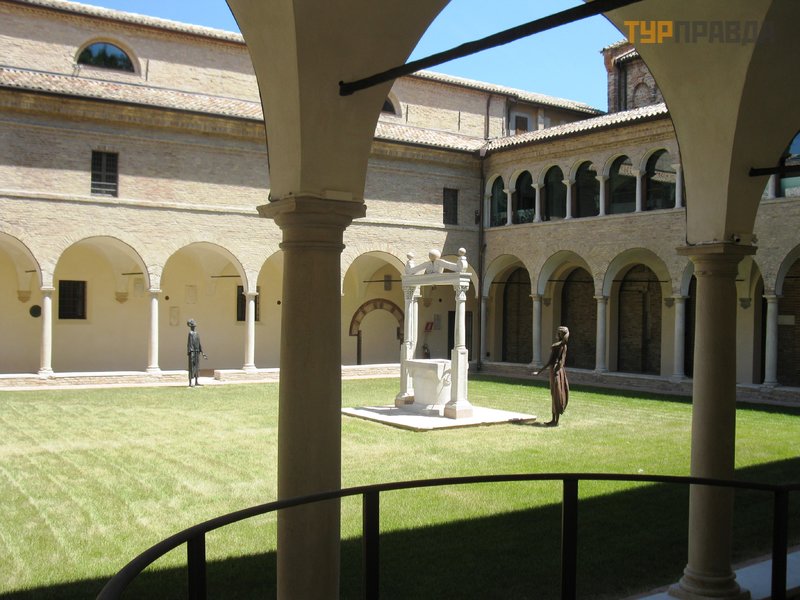 This is an ancient Roman courtyard
This is an ancient Roman courtyard
Ravenna is not nearly as luxurious as its sister Venice, located a little further north along the same Adriatic coast. When Ravenna was going through hard times, the city treasury did not have enough money for marble for finishing buildings - which, in a sense, preserved it in its original form for future generations. Built of brick, it was not subjected to dismantling of valuable rocks when it was necessary to build or restore cathedrals and palaces in Milan or Rome. Therefore, local sights really bear the imprint of the Middle Ages - the "dark" time, from which, according to the generally accepted opinion, it breathes something scary and gloomy. And although there is no smoke without fire (remember the Holy Inquisition), having been in Ravenna, you will understand that even such an era leaves something beautiful in history.
In Ravennathere is also a special attraction - the tomb of Theodoric. This building is unlike any of the many architectural monuments of the city. White, impregnable, it is surrounded by a fence and automatic ticket control in addition to its formidable appearance. The inspirer of this (not fences and control, but a monumental exterior) was the king of the Ostrogoths Theodoric. According to the principle of the Egyptian pharaohs, the royal person decided not to delay the last refuge, and build it during her lifetime. This is perhaps the only building in the city built not from burnt bricks, but from limestone - hence the white color unusual for Ravenna. And the characteristics of the structure are also unique in their own way. What is worth only the roof of the tomb - a huge stone slab, specially brought from the other side of the Adriatic Sea, from Istria. A block with a diameter of 10.5 m and a height of 2.5 m was transported suspended between two ships. After this fact, the scale of the work becomes clear, which confirms the already proven truth: Italian architects are among the best in history. This attraction was left in the end, because. it is located near the d . station, from where we were going to go to the Marina, i. e. seaport.
In the meantime, we headed to the local cult object - the tomb of the great Dante Alighieri, Tomba di Dante. Marble walls and the image of the poet on the pulpit have become the hallmark of Ravenna in Italy.
The mausoleum was erected in the 15th century, only a century and a half after the death of the author of The Divine Comedy. Florence, in which the poet was born, realized a century later, and began to demand the extradition of the remains of Dante. Ravenna - first of all, the Franciscan monks - rested, and did everything in order not to give in. As a result, although the poet was not elevated to the rank of a saint, the worship of his talent is quite comparable. Down the street are several ancient crypts with mosaic floors. Local enterprising citizens have turned this feature into a good source of income. In these crypts, due to their location, the floors are constantly flooded with water. For the opportunity to look at the mosaic floors of the lower floor, against which goldfish swim, you will have to pay half a euro.
Nearby, it is worth seeing the Roman courtyards where patricians lived during ancient Rome. And already coming back, we saw a huge queue in the heat, waiting for tour buses
 The line of tourists for the lion
The line of tourists for the lion
. And in 40 minutes we were on the liner, having passed the route in the opposite direction.
The whole liner is in our hands, we move on - ahead of Bari and Dubrovnik
